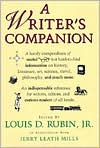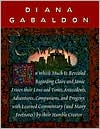A Writer's Companion
In A Writer's Companion, Louis D. Rubin, Jr., has drawn on his years of accumulated wisdom - as well as the advice of some fifty prominent writers from various fields - to put together in a single volume a vast array of information. Organized in such a way as to make it exceptionally easy to use, and enhanced by Rubin's graceful and witty prose, A Writer's Companion will merit a place on the desk of every serious wordsmith. It is also a book that will bring endless hours of pleasure to anyone...
Search in google:
In A Writer's Companion, Louis D. Rubin, Jr., has drawn on his years of accumulated wisdom - as well as the advice of some fifty prominent writers from various fields - to put together in a single volume a vast array of information. Organized in such a way as to make it exceptionally easy to use, and enhanced by Rubin's graceful and witty prose, A Writer's Companion will merit a place on the desk of every serious wordsmith. It is also a book that will bring endless hours of pleasure to anyone who enjoys reading simply for the sake of gaining new knowledge. As Casey Stengel said, "You could look it up."Library JournalFor this companion, Rubin-editor, distinguished scholar, and, most recently, novelist (The Heat of the Sun, LJ 9/1/95)-excluded information found easily in the World Almanac and Roget's but otherwise included miscellaneous information that he and some 55 other writers thought would be helpful and browsable. Their assemblage of information, meant to be "of particular use to writers and editors," has 19 sections (e.g., "Sports," "The Animal Kingdom") divided into 66 subsections (e.g., "Pennant Contenders," "The Pro Quarterbacks"). Like many companions, the book includes unique lists and is fun to browse. However, its content is not as interesting or as useful as that of such books as The People's Almanac or the Book of Lists. This offering would be more useful in the home or office than the library.-Peter Dollard, Alma Coll. Lib., Mich.
Travel and Transportation\ Boats, Ships, and Other Watercraft\ \ Anyone who has ever done much writing about watercraft knows that those who read it tend to be extremely persnickety about nomenclature. Write "bark" when you mean "barkentine," or "battleship" when you mean "battle cruiser," and you are asking for all kinds of trouble. Yet there is by no means general agreement among the experts about such matters; quite the contrary.\ What is the difference between a "boat" and a "ship"? Good question; authorities disagree. A rule-of-thumb distinction has to do with size; that is, you can put a boat on a ship, but you can't put a ship on a boat. Think of it this way. A "ship's boat" is a small craft kept aboard and lowered for use in harbor; a "boat's ship" is the larger vessel that the boat belongs to and can be hoisted onto. Yet that doesn't make a sailboat that keeps a dinghy on the cabin roof into a ship. And in the United States Navy, submarines, which certainly function independently both atop and underneath the surface of the ocean, are traditionally referred to as boats, not ships.\ In short, there is no such thing as unanimous agreement on terminology. In particular, aficionados of sailing vessels can and frequently do dispute at length over exactly what was a brig, a brigantine, a bark, a barkentine, and so on. One man's prau is another man's proa, and so on. Moreover, boats and ships have evolved over the centuries, and their conformations have changed.\ There have been thousands of different kinds of watercraft, ranging from rafts and simple log canoes to full-rigged sailing vessels and giant ocean liners and warships. The compilation thatfollows describes only a few of the most commonly known types, including modern craft and some older craft frequently encountered in books. We have relied in particular on two excellent compilations, Graham Blackburn's Illustrated Encyclopedia of Ships, Boats, Vessels, and Other Water-Borne Craft and Bj”rn Landstr”m's Sailing Ships (see Sources, below).\ For their generous help in making this descriptive compilation as accurate as possible, we are indebted to Capt. Edward L. Beach, USN ret., and John Rousmaniere.\ Aircraft carrier. Flat-decked Navy ship designed to transport, launch, and land airplanes. Known in U.S. Navy as attack carrier. The earliest carriers date from World War I, and were converted naval or cargo vessels which carried seaplanes aboard and lowered them into the water with cranes. The Royal Navy might well have ambushed and trapped the German High Seas Fleet at Jutland in 1916 if Admiral Jellicoe hadn't declined to make use of a seaplane carrier. The "flat-top" with a deck for launching and landing airplanes came soon afterward. The Langley was the first U.S. aircraft carrier. World War II battle fleets in the Pacific developed into fast carrier fleets, with battleships in effect relegated to functioning as antiaircraft protection for carriers and bombarding shore installations. See also Escort carrier.\ Ark. (1) Large vessel of refuge, without means of propulsion, modeled on the biblical ark of Noah; (2) early flat-bottomed vessel on U.S. inland waters for transporting produce.\ Armed merchant cruiser. Large merchant vessel, usually fast, taken over by navy during wartime, armed, and used primarily for convoying and blockading. The Jervis Bay of World War II was an armed merchant cruiser. Also known as auxiliary cruiser; see below.\ Attack transport. Fast Navy ship designed to carry and put ashore troops and equipment, including landing craft.\ Auxiliary cruiser. Armed passenger or cargo vessel converted to naval duty for convoying and patrolling during wartime; see Armed merchant cruiser.\ Banker. Large cod-fishing vessel of the offshore North Atlantic banks. Present-day bankers are motorized; earlier they were schooner rigged. Commonly they carried dories, from which crewmen fished with long lines. Kipling's Captains Courageous is set aboard a banker.\ Barca-longa. Large lugsail-rigged Spanish fishing boat carrying two or three sails.\ Barco de mer. See Fishing boat.\ Barge. (1) Roomy flat-bottomed boat used for transporting goods or passengers in harbors, canals, or waterways, offshore, etc., usually towed but sometimes self-propelled; also known as lighter; (2) older term for any small sailing vessel; also bark; (3) admiral's barge, large Navy boat, earlier rowed but now powered, for harbor transport of flag officers;(4) highly ornamented ceremonial craft; "The barge she sat in, like a burnished throne"--Shakespeare; (5) coastal trading vessel; the Thames barge was flat bottomed, with leeboards, ketch or yawl rigged;\ (6) formerly a double-decked towed vessel for pleasure parties. "Don't barge in on me"--Anon.\ Bark. Three-masted sailing vessel, with foremast and mainmast square rigged, mizzenmast fore and aft rigged; also barque. Earlier the term was used for any small sailing craft. The jackass-bark has square top- and topgallant sails on the mainmast but the lower main is fore and aft rigged. The four-masted bark carries square-rigged fore-, main-, and mizzenmasts, and fore-and-aft sails on the aftermast. "Yond tall anchoring bark/Diminish'd to her cock, her cock a buoy/Almost too small for sight"--Shakespeare, King Lear.\ Barkentine. Three-masted sailing vessel similar to a bark but with only the foremast square rigged. Also barquentine.\ Bassboat. Fast motor craft for inland pleasure fishing developed in 1960s, cathedral hulled with very low freeboard, decked-over blunt bow, very stable, with high pedestal seats at bow and stern, powered by outboard engine.\ Bathysphere. Diving sphere for deep-sea observation and study.\ Batteau. (1) Light flat-bottomed skiff, rowed or poled, tapering to blunt ends; (2) double-ended flat-bottomed rowing craft, sharp raked, used on lakes and rivers of northern North America. Also bateau.\ Battle-cruiser. Large warship built by British and Germans for First World War, similar to battleship and with long-range guns, but faster and with lighter protective armor. The lack of protection proved disastrous; wrongly used as part of the battleline, three were sunk in a couple of hours at Jutland in 1916. The HMS Hood, sunk by a single salvo fired by the Bismarck in 1942, was Great Britain's most famous battle-cruiser.\ Battleship. Largest, most heavily armed and armored of a navy's warships. Early battleships, which were direct descendants of the sailing ships-of-the-line or line-of-battle-ships, were known as ironclads. The British HMS Dreadnought, launched in 1906 at the instigation of Admiral Sir John Fisher, displaced 17,900 tons, and its big guns were all of the same caliber. Its advent rendered all earlier battleships obsolete, and its name became generic for the largest battleships; but by World War I, the heyday of the battleship, it too was outdated by larger and more formidable craft. The last major surface engagement of battleship fleets was Jutland, in 1916, in which the British Grand Fleet, although suffering greater damage, drove the German High Seas Fleet back to cover. In World War II, battleship fleets fought no major surface engagements. The German Bismarck, after sinking the British battle-cruiser Hood in the North Atlantic, was ultimately disabled and slowed by aerial attack and sunk by torpedoes, bombing, and shelling. In 1942 the USS Washington disabled the Japanese battleship Kirishima to the point where she was scuttled by her own forces. The largest battleships ever built were Japan's 72,000-ton Yamato and Musashi; both were sunk by aerial attack. During the Korean, Vietnam, and Desert Storm conflicts, American battleships of World War II vintage such as the Missouri, Iowa, and Wisconsin were restored to service, modernized, and stripped of all but big guns and antiaircraft batteries, and used to shell shore installations. "Sailors, who pitch this portent at the sea/Where dreadnoughts shall confess/Its hell-bent deity"--Robert Lowell.\ Bergantina. Small Mediterranean rowing or sailing vessel often carried dismantled aboard larger sailing ships in the fifteenth and sixteenth centuries.\ Billy-boat. Merchant ship of the seventeenth and eighteenth centuries, with square-rigged foremast and cut-off lateen mainsail. Also bilander.\ Bireme. Galley with oars on two banks or in groups of two, usually with outriggers, used in the Mediterranean from the seventh century b.c.e. onward.\ Block Island boat. Cat-rigged yawl or ketch, with masts of equal height, with short keel.\ Bomb-ketch. Sturdily constructed sailing vessel with main- and mizzenmasts, and with foremast removed to accommodate heavy mortars.
Preface and Apologia: Why This Particular Reference Book?ITravel and TransportationIIHistory and PoliticsIIIArchitectureIVPainting and SculptureVMusic, Classical and PopularVILiterature and LanguageVIIDrama and TheaterVIIIRadio, Television, and FilmIXReligion, Folklore, and LegendXNative AmericansXIBusiness and FinanceXIIThe Animal KingdomXIIIScience and the Natural WorldXIVPsychoanalysisXVLaw and LawsXVIPhilosophyXVIIGastronomyXVIIISportsXIXReference
\ Library JournalFor this companion, Rubin-editor, distinguished scholar, and, most recently, novelist (The Heat of the Sun, LJ 9/1/95)-excluded information found easily in the World Almanac and Roget's but otherwise included miscellaneous information that he and some 55 other writers thought would be helpful and browsable. Their assemblage of information, meant to be "of particular use to writers and editors," has 19 sections (e.g., "Sports," "The Animal Kingdom") divided into 66 subsections (e.g., "Pennant Contenders," "The Pro Quarterbacks"). Like many companions, the book includes unique lists and is fun to browse. However, its content is not as interesting or as useful as that of such books as The People's Almanac or the Book of Lists. This offering would be more useful in the home or office than the library.-Peter Dollard, Alma Coll. Lib., Mich.\ \ \ \ \ From The CriticsAn assessment of "A Writer's Companion" will most likely depend upon the setting in which it is used. Its two Library of Congress subject headings sum up the options. In a library, especially one with a reasonably good reference collection, the subject heading "Literary curiosa--Handbooks, manuals, etc." characterizes it well. If, on the other hand, one is an author or editor working outside a library, then the other heading fits: "Handbooks, vade-mecums, etc." Rubin explains that this book is "not designed to replace specialized reference sources" but "gather[s] material . . . in sufficient detail, on a variety of topics--topics about which, from my own experience and that of others, it seemed to me that writers and editors would find useful to have information available within the covers of a single volume. In the absence of an index, the primary point of access to the book is the table of contents, an outline of its 19 topical chapters. Broad topical areas covered include transportation, architecture, music, literature and language, religion and folklore, psychoanalysis, philosophy, gastronomy, and sports. The most thoroughly developed chapters are those that apply to the arts, history, and transportation/travel. Each section is a list, generally briefly annotated, of something--for example, downtown hotels in American cities, historical battles, great architectural works, notable sculptors, famous operas, current slang, popular radio shows, ancient deities, professional quarterbacks, or "some reference books that writers use." This last chapter is an ironic coda; like the references at the conclusion of each subsection, it cites numerous specialized sources that in almost every case outperform the lists in "A Writer's Companion". Yet writers should be wary of its recommendations of superseded editions of Bartlett's "Familiar Quotations", the "Columbia Encyclopedia", and the "Times Atlas of the World" One cannot deny that a certain delight can be had by browsing through a list of occupations famous writers have filled, a list of famous cats, or statements of immutable laws in science and other fields. This book, much like the "The People's Almanac Presents the Book of Lists" (Little, Brown, 1993), can be great fun to browse. However, neither is a reference work of choice for libraries, especially not "A Writer's Companion", most of whose sections have authoritative, more comprehensive, more informative book-length counterparts in reference collections.\ \ \ BooknewsNot particularly about writing, but a compilation of a vast array of factual data to answer the practical reference needs of writers and others--the information that keeps writers in the library for hours. Sixty-six topics are covered under 19 categories. The range of information provided is suggested by the range of writers Rubin consulted for suggestions about what might be included--art historians, novelists, newspaper columnists, psychiatrists, literary critics, political scientists, sports writers, political and military historians, philologists, classical scholars, theologians, poets, editors and publishers, and writers on music. Not only useful but vastly entertaining--as suitable for browsing as for research. Annotation c. Book News, Inc., Portland, OR (booknews.com)\ \








